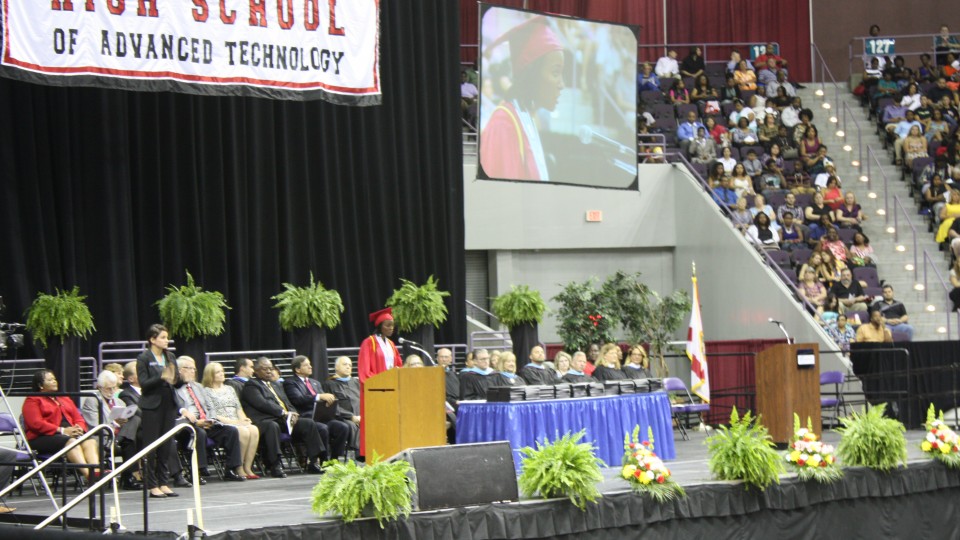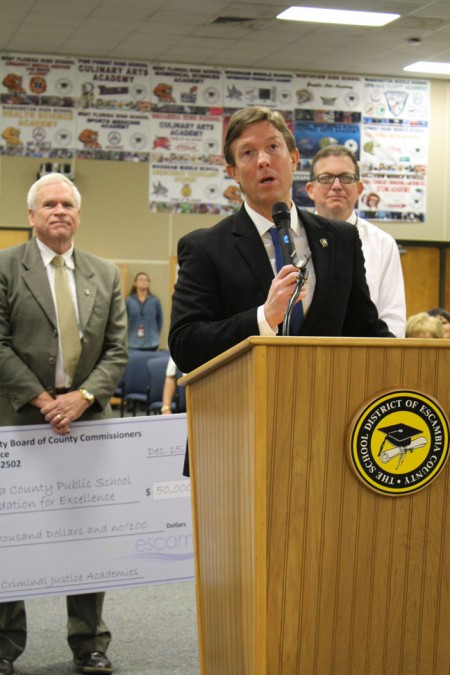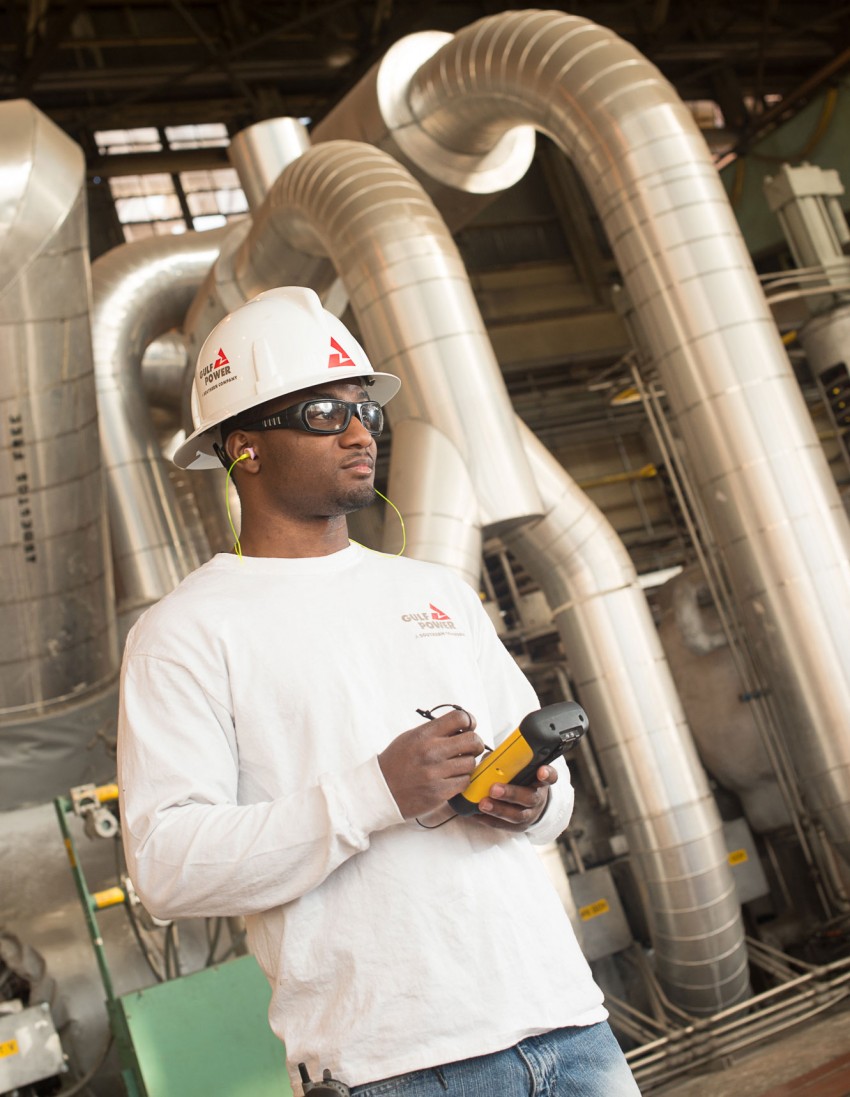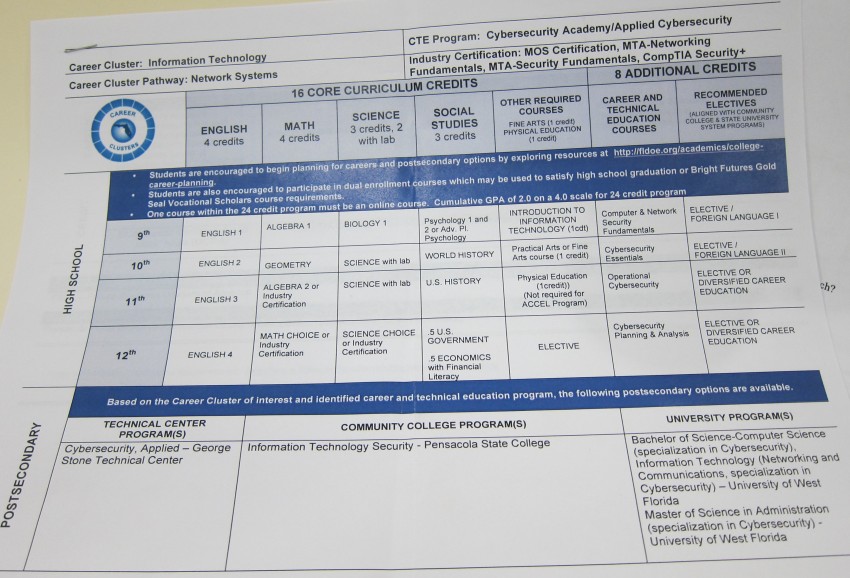What career academies bring to the table
- December 23, 2015
- / Shannon Nickinson
- / education

West Florida senior Raleigh Nesbitt delivering her speech during the 2015 graduation ceremony.
It is a partnership that seems made in education heaven.
The firefighter academy at Pine Forest High School and a law enforcement academy at Escambia High will create a pipeline of students getting real-world experience for jobs they know will exist after graduation.
The county, after wrestling with shortages of both firefighters and law enforcement and corrections officers, contributed $50,000 to the school district’s foundation to support the new academies.

Escambia County Commissioner Steven Barry at the meeting announcing Escambia County's contribution to two career academies. Photo credit: Escambia School District
“Not only is it good for students, but employers are literally starting to see these high school career academies as a feeder for trained employees, or at least for identifying potential employees,” says Michelle Taylor director of workforce education for the school district.
Taylor is the guru of career academies for the district, which now count some 18,167 students — nearly half of all Escambia’s school students.
The academies are curriculum tracks, tied to an industry or business, that combine traditional academics with the real world application of those concepts based on the industry track the academy is tied to.
Research suggests that career academies engage students more and may lead to higher graduation rates and better job prospects.
That is crucial in a community like Escambia County, where the high school graduation rate stands at 66.1 percent — and where 49.8 percent of African-American students get diplomas.
The high school graduation rate is one of 16 metrics in the Studer Community Institute’s Pensacola Metro Dashboard, developed with the University of West Florida, to gauge the economic, educational and social well-being of the community.
The most mature career academy is the Gulf Power academy at West Florida High School, which opened in 2001 as a high school built solely around the career academy philosophy.
For nine years, it has been the only Escambia high school to earn an A on state standardized tests.
It includes students who go on to four-year colleges, post-secondary training or the workforce.
Ninety-four percent of West Florida’s students graduate in four years.
Taylor calls the Gulf Power Academy at West Florida “Mecca. It is the holy grail. It is exactly the model of career academies to which we aspire for our career academies. It contains the components of the actual career technical training, with rigorous academics, with industry certifications, a certified teacher.”
MDRC, a nonprofit research entity founded in 1974 by the Ford Foundation, reported in 2008 that career academy participation increased a student’s earning power and work prospects once out of school.
In that study, completing a career academy led to an 11 percent increase in annual earning power for students that lasted throughout the eight years of follow-up researchers conducted — which translated to an average of $2,088 more a year in earnings.
For Gulf Power it has been a very fruitful partnership.

After graduating from West Florida High School in 2006, Alex Allen now is a plant control operator at the Gulf Power Crist Plant in Pensacola. He is pursuing an engineering degree. Michael Spooneybarger/Studer Community Institute
Jeff Rogers, Gulf Power spokesman, says the utility has hired 57 graduates from the Gulf Power Academy since 2005.
These new hires have come in many ways, Rogers says, — right out of high school, after additional training, and after bachelor’s degrees.
“We typically hire them into entry-level positions in our generating plant, line crews, customer service and engineering,” he says. “All come in with enhanced knowledge of the company, our product, our customers, and our culture.
“Yes, it has been a successful partnership and we are thrilled we could be in on the ground floor of (West Florida High School), which we believe to be a model for how to blend high academic standards with career and technical education.”
Growing the model
Even as research shows the powerful positive influence this model of high school education can have on students, it wasn’t until the 2015-2016 school year that another Escambia high school — Pine Forest High School — copied the West Florida model and went to “wall-to-wall” career academies.
“Research supports that a student who is involved in a career academy, graduate at a higher rate than students who don't,” Taylor says. “I have a theory that if you took any course of study, be it chorus or ROTC, it doesn't matter. It's the belonging and the purpose that makes the career academy model successful. On top of it, you have the other elements of connecting to a possible job later on.”
“It really is about the high school leadership, and to what to they aspire. Thankfully for us, Frank Murphy said he wanted to go wall to wall at Pine Forest,” Taylor says. “He's now at Escambia High School. We expect to see those career academies really flourish there….It's leadership. It's somebody who has said ‘I see my kids need this.’"
The Florida Department of Education found that students in career academies had better attendance, higher grade point averages, and students who earned certifications were more likely to take dual enrollment or Advanced Placement classes than students who didn't earn certifications.
Academies for college-bound kids too
Taylor now is in the process of assessing the district’s academies to make sure they meet not only an educational but also a workforce need. It’s something she says was last done “several years ago.”
She will create an evaluation tool that will track, among other things, placement data.
Placement is three outcomes: the student is working in the field the following year after they leave, the student is continuing their education, or the student has joined the military.
Taylor says another measure of success is whether kids sign up.
“If we struggle to get enough students to make a class, we have a problem.”

A typical class outline for the cybersecurity career academy at Pine Forest High School. Shannon Nickinson/Studer Community Institute
Another part of the struggle is getting parents to buy in to the idea that career academies are also for students who are pursuing college education.
“As a matter of fact, it's probably taken advantage of more by students who are wanting to pursue post-secondary,” aylor says. “With the cost of college so high, you know how certain things, either you like it or you don't like it? That's a good time to find out before you go off and start having to pay thousands of dollars. I like to think that these academies are for college bound.”
Focus now on getting the word out
Taylor says the partnership with FloridaWest economic development agency has been really powerful.
“They help us get the data that we can inform our counselors, our parents, our students about opportunities for kids, and how participating in academies help them,” she says.
That led to the Career Pathways website, an online resource housed by FloridaWest that ties jobs that will be growing in the coming years to the kind of classes in middle and high school and beyond if necessary someone who need to be prepared for them.
In mid-December district officials met with guidance counselors in Escambia and Santa Rosa counties to brief them on the portal and ask for their ideas about how to get the word to parents.
“Here's our challenge,” Taylor says. “How do we get parents and students to want to sign up and learn about advanced manufacturing and about aviation maintenance? How do we teach kids that they're hard work, but that hard work pays dividends.
“Unfortunately some parents look at the blue collar, get your hands dirty kind of jobs and go "No, no, no, my kid's going to college."
Taylor says her department has hired a career education coach whose job it is to help spread the word among middle school students about the ways academies can help students face the future.
“I still feel as though we need special strategies to sell these important areas that don't get as much respect as some of the other well-known areas.”
“That is just an area that we need to continue to identify strategies to reach the parents so that they can help their kids make good choices,” Taylor says. “When the parents are lifted up, it lifts up our students. We know that.”
 CivicCon launches with a look at good growth in cities
CivicCon launches with a look at good growth in cities
 Building stronger brains one baby, one parent at a time
Building stronger brains one baby, one parent at a time
 SCI debuts commercial on Early Learning City
SCI debuts commercial on Early Learning City
 Entrecon: World class speakers and an opportunity to sharpen skills
Entrecon: World class speakers and an opportunity to sharpen skills
 PYP Quality of Life survey 2017
PYP Quality of Life survey 2017
 EntreCon Pensacola 2016: A look back
EntreCon Pensacola 2016: A look back
 Leadership tip: getting better employee takeaways
Leadership tip: getting better employee takeaways
 Leadership tip: be interested instead of interesting
Leadership tip: be interested instead of interesting
 Leadership tip: delivering difficult messages
Leadership tip: delivering difficult messages
 Brain Bags boost Arc, Early Childhood Court programs
Brain Bags boost Arc, Early Childhood Court programs